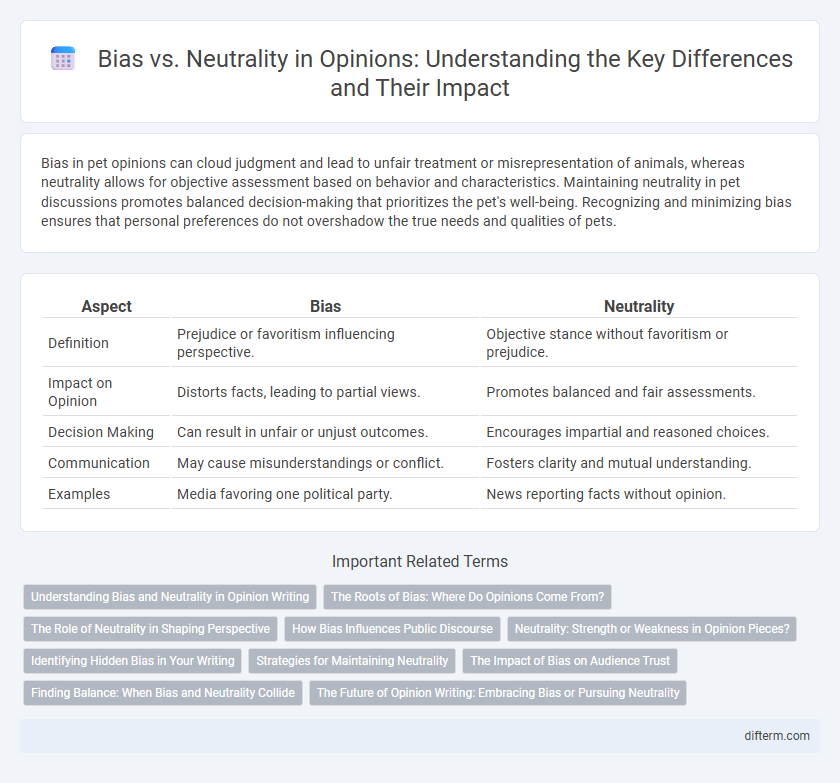Bias in pet opinions can cloud judgment and lead to unfair treatment or misrepresentation of animals, whereas neutrality allows for objective assessment based on behavior and characteristics. Maintaining neutrality in pet discussions promotes balanced decision-making that prioritizes the pet's well-being. Recognizing and minimizing bias ensures that personal preferences do not overshadow the true needs and qualities of pets.
Table of Comparison
| Aspect | Bias | Neutrality |
|---|---|---|
| Definition | Prejudice or favoritism influencing perspective. | Objective stance without favoritism or prejudice. |
| Impact on Opinion | Distorts facts, leading to partial views. | Promotes balanced and fair assessments. |
| Decision Making | Can result in unfair or unjust outcomes. | Encourages impartial and reasoned choices. |
| Communication | May cause misunderstandings or conflict. | Fosters clarity and mutual understanding. |
| Examples | Media favoring one political party. | News reporting facts without opinion. |
Understanding Bias and Neutrality in Opinion Writing
Recognizing bias in opinion writing involves identifying subjective language and one-sided arguments that favor a particular perspective while neglecting opposing views. Neutrality is achieved by presenting balanced evidence and acknowledging multiple viewpoints to foster informed judgment. Understanding these concepts improves critical reading skills and promotes fair, reasoned discussions.
The Roots of Bias: Where Do Opinions Come From?
Opinions stem from a complex interplay of cognitive processes, social influences, and personal experiences that shape one's perception of reality. Bias originates when these factors create selective attention and interpretation, filtering information through subjective lenses rather than objective standards. Understanding the neural and psychological roots of bias is crucial for fostering greater neutrality and critical thinking in evaluating information.
The Role of Neutrality in Shaping Perspective
Neutrality plays a crucial role in shaping perspective by allowing individuals to evaluate information without the distortion of personal biases. Maintaining an unbiased stance fosters objective analysis, enabling clearer understanding and more balanced decision-making. Emphasizing neutrality promotes open-mindedness and reduces the influence of preconceived notions in forming opinions.
How Bias Influences Public Discourse
Bias significantly shapes public discourse by distorting information and reinforcing stereotypes, which can polarize opinions and limit critical thinking. Media outlets with biased perspectives often prioritize sensationalism over factual accuracy, eroding public trust and creating echo chambers. This influence hinders the development of balanced viewpoints, preventing meaningful dialogue and consensus-building in society.
Neutrality: Strength or Weakness in Opinion Pieces?
Neutrality in opinion pieces can strengthen credibility by presenting balanced perspectives that foster trust and encourage critical thinking. However, excessive neutrality may dilute the writer's voice, leading to a lack of engagement and persuasive power. Striking an optimal balance ensures opinions are both credible and compelling, enhancing overall impact.
Identifying Hidden Bias in Your Writing
Identifying hidden bias in your writing requires careful examination of word choice, tone, and source selection to ensure balanced representation. Paying attention to culturally loaded terms and avoiding generalizations helps maintain neutrality and credibility. Employing diverse perspectives strengthens objectivity and mitigates unconscious bias in your content.
Strategies for Maintaining Neutrality
Maintaining neutrality requires recognizing inherent biases and implementing strategies such as fact-checking, considering multiple perspectives, and avoiding emotional language. Employing systematic frameworks like the CRAAP test (Currency, Relevance, Authority, Accuracy, Purpose) enhances objective analysis. Consistent self-reflection and seeking peer feedback further strengthen impartiality in opinion formation.
The Impact of Bias on Audience Trust
Bias significantly undermines audience trust by distorting information and promoting partial viewpoints that compromise credibility. Neutrality fosters objectivity, enabling audiences to form informed opinions based on balanced facts rather than skewed narratives. Audience trust deteriorates rapidly when bias is detected, leading to skepticism and disengagement from the source.
Finding Balance: When Bias and Neutrality Collide
Finding balance between bias and neutrality requires acknowledging inherent perspectives while striving for objective clarity. Recognizing personal and cultural biases allows for critical self-reflection that enhances decision-making and communication. Emphasizing transparency and evidence-based reasoning helps maintain credibility amidst subjective viewpoints.
The Future of Opinion Writing: Embracing Bias or Pursuing Neutrality
Opinion writing's future hinges on balancing bias and neutrality; embracing bias allows for passionate, authentic voices that engage readers, while pursuing neutrality supports credibility and trustworthiness. Advances in digital media amplify diverse perspectives, making transparency about biases crucial for informed audiences. Cultivating critical thinking in readers ensures opinion pieces enrich public discourse without sacrificing intellectual integrity.
bias vs neutrality Infographic

 difterm.com
difterm.com